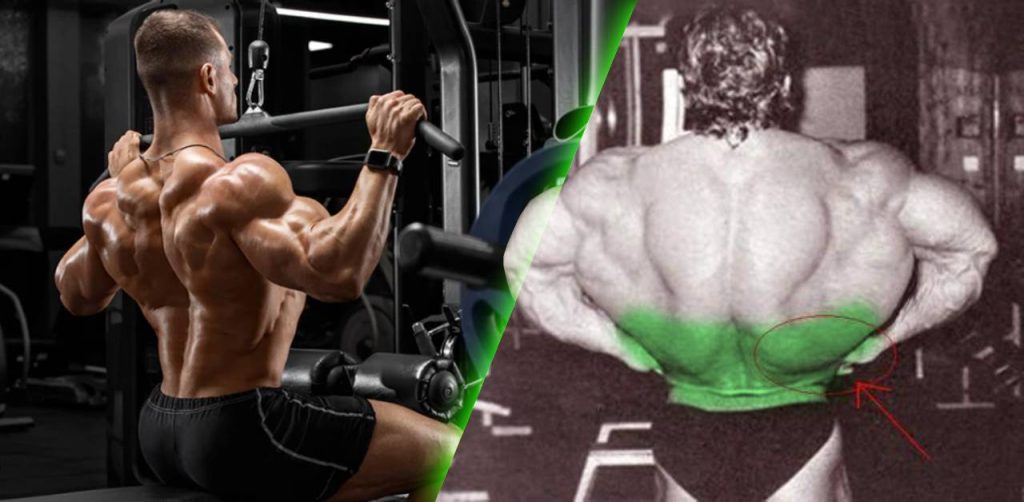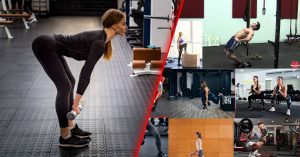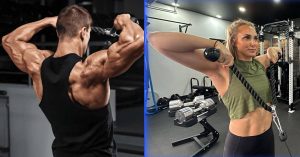Have you ever seen someone with a back so well-defined it seems sculpted by an artist? That’s not just any regular workout result; that’s the magic of focusing on the lower lats. Are you ready to discover how to achieve that powerful, eye-catching look? The answer is lower lats exercises and in this guide I will cover everything you need to know about it.
Table of contents
MORE keyboard_double_arrow_down LESS keyboard_double_arrow_up
The Role of Your Lats
Your latissimus dorsi, or lats, are among the most significant muscles in your back, extending from beneath your arms all the way to your waist. Here’s why they’re crucial:
- They play a key role in supporting your upper body, aiding in everything from lifting heavy objects to performing everyday tasks.
- Your lats are involved in numerous motions, including pulling, lifting, and reaching.
- They contribute to spinal stability, which is essential for good posture and preventing back pain.
The Best Lower Lat Workouts
Now that you know the importance of your lats, let’s find out what exercises are ideal for working out your lats.
Wide Grip Lat Pulldown
The wide grip lat pulldown exercise is a great lower lats workout which helps to focus on developing the lower and outer portions of your latissimus dorsi (lats), the large muscles in your lower back.
Here’s why it’s effective:
- Compared to the close-grip version, the wider grip minimizes the use of your biceps and forearms, placing more emphasis on your lats to pull the weight down.
- The wider grip allows you to alter your arm angle during the movement, pulling your elbows closer to your body at the bottom. This movement targets the lower lats more effectively.
- By reducing the reliance on biceps and forearms, the exercise translates to higher tension on your lats, leading to greater strength and muscle growth.
- This exercise can also be beneficial for improving your V-shape aesthetics, particularly the ratio between your shoulders and waist.
Here’s how to perform the wide grip lat pulldown:
- Sit on the lat pulldown machine and secure your thighs under the pad.
- Grasp the bar with a wide overhand grip (slightly wider than shoulder-width). Lean back slightly and inhale.
- Pull the bar down towards your mid-chest while maintaining a tight core. Exhale as you pull.
- Hold briefly at the bottom, then slowly return to the starting position.
- Aim for 3-4 sets of 12-15 repetitions.
Tip: Avoid overly wide grips, as this can hinder your ability to generate force effectively.
Dumbbell Row to Hips
Single-arm rows are fantastic dumbbell lat exercises for building upper back strength and addressing imbalances between your left and right sides. With a slight modification, they can become even more effective at targeting your lower lats.
Benefits:
- The larger range of motion and pulling motion place greater tension on your lower lats, leading to improved strength and development.
- Pulling back instead of rowing up helps minimize the use of your upper trapezius muscles, preventing them from taking over the movement.
- Working one arm at a time allows you to address any strength differences between your left and right sides.
How to do it:
- Support your non-working hand on a bench or rack and step back with the opposite leg for stability.
- Hold a dumbbell in your working hand with a neutral grip (palm facing your body) inside your front foot. Keep your shoulders down and chest lifted.
- Row the dumbbell towards the outside of your hip, keeping your back straight and core engaged. Imagine putting your elbow in your back pocket as you pull.
- Hold briefly at the top of the movement, then slowly lower the weight back to the starting position.
- Perform 4 sets of 8-12 repetitions per arm.
Tip: Focus on using controlled movements throughout the exercise and avoid jerky motions.
Seated Band Row
Seated band rows are a great exercise for building back strength and targeting your latissimus dorsi (lats) muscles. They offer several advantages over traditional lat exercises with dumbbells or barbell rows:
- The resistance band provides consistent tension throughout the entire movement, maximizing muscle engagement in your lats.
- The band allows for a wider range of motion and a more natural pulling motion, reducing restrictions and promoting better form compared to fixed weights.
- The constant, but gentle, tension of the band can be easier on your joints than heavier weights, making it a suitable option for beginners or those recovering from injuries.
- Resistance bands are portable and easy to use anywhere, making this exercise ideal for home workouts or as a warm-up/cool-down tool.
Here’s how to perform seated band rows:
- Sit on the floor with your legs extended. Loop a resistance band around the middle of your feet and hold an end in each hand.
- Maintain a straight back and core engagement throughout the exercise.
- Fully extend your arms straight out in front of you. Initiate the movement by pulling your elbows back and squeezing your lats, bringing your hands towards your torso. Aim to bring your elbows past your body for full engagement.
- slowly return your arms to the starting position with controlled movement.
- Keep your elbows tucked in close to your sides for a stronger emphasis on your lower lats.
Tip: Focus on using your lats to initiate the pulling motion, not your traps. You can also try different band thicknesses to adjust the difficulty level.
Straight Arm Lat Pulldown
The straight-arm lat pulldown is an exercise that specifically targets your latissimus dorsi (lats), the large muscles in your lower back. It’s particularly beneficial for:
- By keeping your arms straight throughout the movement, you minimize involvement of the biceps, allowing you to focus the work directly on your lats. This is especially helpful if you struggle to feel your lats engaging during other pulling exercises.
- Strengthening your lats can significantly aid in your deadlifting performance as the lats play a crucial role in maintaining back stability and supporting the pulling motion.
- This exercise puts minimal stress on your joints, making it a suitable option for beginners or those recovering from injuries.
Here’s how to perform the straight-arm lat pulldown:
- You can use either a cable machine or a resistance band with an appropriate attachment (straight bar, handles, or rope).
- Grab the attachment with an overhand grip. Take a step back and lean your torso slightly forward while maintaining your arms straight and hands above shoulder height.
- Engage your lats and pull the attachment down towards your hips while keeping your arms completely straight. Pause briefly at the bottom of the movement.
- Slowly return the attachment to the starting position by resisting the weight throughout the return movement (eccentric).
- Aim for 2-3 sets of 12-15 repetitions.
Tip: Focus on using your lats to initiate the pulling motion, not your biceps. You can adjust the weight or band resistance based on your strength level.
Underhanded Bent Over Row
The underhand bent-over row is a variation of the traditional bent-over row that specifically targets the lower lats and biceps along with other upper back muscles. Here’s why it’s effective:
- This grip promotes greater scapular depression, a movement where your shoulder blades squeeze together and downward. This motion engages the lower portion of your lats more effectively than the overhand grip.
- The underhand grip also allows for increased bicep recruitment, which can be beneficial for overall upper body development.
- This exercise reinforces proper hip hinge mechanics, a crucial movement pattern for exercises like deadlifts and essential for lower back health.
How to perform the underhand bent-over row:
- Stand with your feet shoulder-width apart and hinge at your hips, maintaining a flat back and core engagement.
- Grab a loaded barbell with an underhand grip (palms facing you) slightly wider than shoulder-width.
- Row the barbell up towards your stomach by squeezing your shoulder blades together and pulling with your lats and biceps. Keep your elbows close to your torso throughout the movement.
- Hold the weight briefly at the top of the movement, then slowly lower it back to the starting position in a controlled manner.
- Aim for 3-4 sets of 5-8 repetitions.
Tip: Keep your upper arms close to your body (external shoulder rotation) throughout the exercise to maximize lower lat engagement.
The Importance of a Targeted Warm-Up
Jumping straight into intense lower lat exercises without a proper warm-up is like trying to sprint without stretching—risky and counterproductive. Here’s what a focused warm-up does for you:
- Warming up gets the blood flowing to your lats, ensuring they’re ready for the workout.
- A good warm-up increases muscle elasticity, which can help prevent tears and strains.
- When your muscles are warm, they perform better. You’ll likely see improvements in both strength and flexibility during your workout.
Experts Insights and Tips on Lower Lat Exercises
Dr. Jonathan Mike, PhD, CSCS, NSCA-CPT, is an Assistant Professor of Exercise Science at the University of Louisville. He suggests focusing on the contraction of the lats during exercises like lat pulldowns and rows. According to him, “Squeeze your shoulder blades together and focus on pulling your elbows down and back to target the lats.”
Furthermore, Jeff Cavaliere, MSPT, CSCS, is a physical therapist and strength coach who has worked with professional athletes. He emphasizes the importance of maintaining a neutral spine during lat exercises. He says, “Keep your spine in a neutral position by bracing your abs and squeezing your glutes. This will help you to isolate your lats and prevent injury.”
Lastly, Eric Cressey, MA, CSCS, is a renowned strength and conditioning coach. He advises using a slower tempo during lat exercises to increase time under tension and stimulate muscle growth. He says, “Try slowing down the eccentric (lowering) phase of lat exercises. This can help to increase muscle activation and lead to better results.”
Wrapping Up
Building well-defined lower lats requires targeted exercises that focus on this specific muscle group. This guide explores various exercises like wide-grip lat pulldowns, dumbbell rows to hips, and underhand bent-over rows, each offering unique benefits and proper form instructions.
Remember to prioritize proper form and a focused warm-up before engaging in these exercises to maximize results and minimize the risk of injury.
Key Points
- A thorough warm-up, including foam rolling and dynamic stretches, is crucial for priming the lower lats for a workout, enhancing blood flow, and reducing injury risk.
- Developing the lower lats requires a well-thought-out plan that balances exercise volume, intensity, and variety, emphasizing the importance of structured sets, reps, and rest periods.
- Success in lower lat development hinges on not just the exercises chosen but also on the execution nuances, such as proper grip use and maintaining a strong mind-muscle connection.
- Training the lats goes beyond aesthetic improvements, offering functional benefits like enhanced posture, injury prevention, and improved performance in other lifts.
- A solid grasp of lat anatomy, including the distinction between upper and lower lats, is key to targeted training and achieving the desired V-taper physique.
- Implementing the knowledge into practice through step-by-step exercise execution, listening to one’s body, and adjusting intensity for sustainable progress is vital.
- Achieving significant lower lat development is a journey that combines the right exercises with smart training principles, requiring patience and consistent effort.
FAQs
How Do You Work Your Lower Lats?
To effectively target your lower lats, incorporate a variety of exercises that engage this specific area for improved posture, enhanced back strength, and upper body stability. Recommended exercises include:
- Seated Resistance Band Rows: Focuses on the lower lats and improves upper body stability.
- Wide-Grip Lat Pulldown: Targets the outer and lower parts of the lats.
- Dumbbell Row to Hips: Engages the lower lats through an arc-like motion.
- Bent Over Barbell Row: Strengthens the upper back and lower lats.
- Deadlift: Involves the lats throughout the lifting phase.
- Low Pulley Row: Allows for a concentrated pull from the lower lats.
- Straight-Arm Pulldowns: Isolates the lats with minimal bicep involvement.
- Under-Handed Bent Over Rows: Specifically targets the lower lats with an underhand grip.
Why Are My Lower Lats Not Growing?
A common issue with lat development, particularly the lower lats, is not fully utilizing the muscle’s activation patterns. For instance, the second half of a pull-up motion is crucial for maximal lat engagement.
Many individuals fail to grow their lower lats because they do not complete the movement through its full range of motion, often stopping at half-chin-ups due to the ease compared to full pull-ups.
How Do I Only Target My Lats?
Targeting your lats specifically can be achieved through exercises designed to isolate these muscles as much as possible:
- Pull-Ups: A fundamental exercise that targets the lats, with various grips to modify the focus.
- Cable Row: Engages the lats along with other back muscles.
- Deadlifts: While primarily a leg and lower back exercise, deadlifts also engage the lats.
- Barbell Rows: Focus on the lats by pulling the barbell towards your waist.
- Lat Pull-Downs: A versatile machine exercise for targeting the lats.
- Dumbbell Rows: Allow for unilateral lat engagement.
- Landmine Rows: Offer a unique angle to hit the lats.
- Negative Pull-Ups: Emphasize the eccentric phase for lat development.
Do Pull-Ups Hit Lower Lats?
Yes, pull-ups, especially when performed with a shoulder-width grip, effectively target the lower lats. The narrower grip allows for a longer range of motion, which not only engages the upper lats as primary movers but also significantly involves the lower lats. This exercise is excellent for those aiming to develop their lower lat muscles.

ABOUT THE AUTHOR
Follow Valen Steven for a dose of fitness enthusiasm, evidence-based advice, and a roadmap to achieving your health and wellness goals.
Subscribe to our Newsletter
Dive into a world of fitness and wellness with our exclusive newsletter! Sign up now and receive weekly power-packs of fitness wisdom




